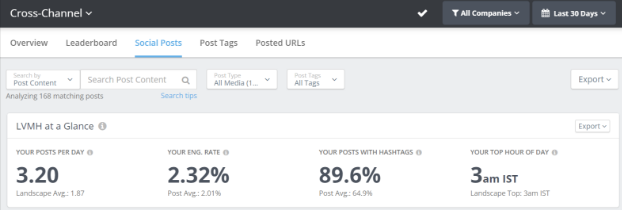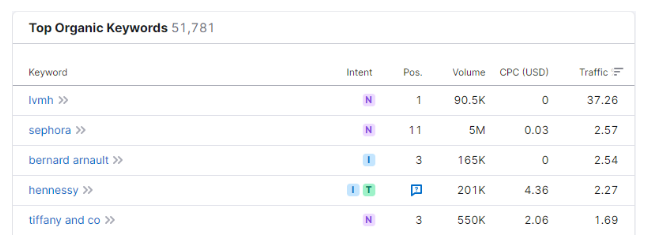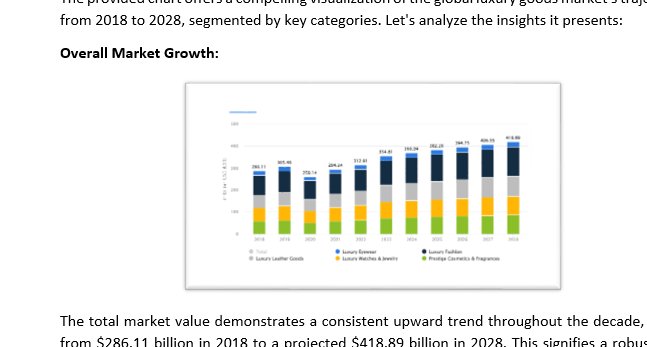Published Date - April / 2024

LVMH, a titan in the luxury goods market, showcases a remarkable presence across multiple channels. Let’s delve into the crucial statistics:
Audience Reach: A staggering 2.28 million individuals follow LVMH across its diverse channels, showcasing its expansive reach and brand recognition.
Posts Content: With 96 posts, LVMH maintains a consistent dialogue and engagement with its audience. The content likely varies across platforms, tailored to suit the specific preferences of each channel’s user base.
1.10 Million Engagements: This underscores the effectiveness of LVMH’s content strategy in resonating with its audience. The luxury brand adeptly cultivates interactions, fostering a community around its offerings and ethos.
Most Engaging Channel – TikTok: The prominence of TikTok underscores LVMH’s acumen in understanding contemporary social media trends. The platform’s succinct video format likely enables the brand to showcase its products in a captivating and visually appealing manner, captivating the attention of a younger demographic.
Analyzing LVMH’s Social Media Engagement: Statistical Breakdown

LVMH’s social media strategy isn’t just about being there. They are really active and involved with their audience, and the numbers prove it:
How Often They Post: They post a lot more than others, about 3.20 times every day! Most brands post only 1.87 times, but LVMH keeps their audience interested by sharing stuff regularly.
How Much People Engage: When it comes to likes, comments, and shares, LVMH is ahead with a 2.32% engagement rate, while the average is only 2.01%. That means people really like what they see and want to talk about it.
Using Hashtags: LVMH uses hashtags a lot more than others, almost 90% of the time! This probably helps more people find their posts and join in on the conversation.
When They Post: Surprisingly, they often post at 3:00 AM IST, which is pretty unusual. It seems like they found a sweet spot when people are not expecting it, maybe to catch the attention of folks in different time zones.
A Detailed Analysis On LVMH’s Facebook Performance

Let’s take a closer look at LVMH’s top Facebook posts and what they tell us:
Engagement: Certain posts grabbed a lot of attention and interaction from the audience. They received a significant amount of likes, comments, and shares, indicating a strong connection with the audience.
Reactions: Across these posts, reactions were the main form of engagement. People expressed their feelings through likes and other emojis, showing what resonated with them.
Comments & Shares: Some posts sparked more conversation and sharing than others. They got more comments and shares, suggesting they struck a chord with the audience.
Overall Trend: When we look at all the posts together, we notice patterns. Some posts consistently received higher engagement than others. It might be beneficial to understand what made those posts successful and incorporate similar elements into future content strategies.
An Analytical Perspective Of LVMH’s Instagram Channel

Let’s break down how LVMH is doing on Instagram:
Followers Reach: LVMH has a big following of about 1.18 million people. That means a lot of folks are checking out their stuff on Instagram.
Posts Content & Engagement: They have only posted 21 times, but each one seems carefully chosen. It’s like they are going for quality over quantity, which can make each post feel special.
Engagement Total: People seem to like what they see, with a total of 204K likes, comments, and shares. Not bad for just 21 posts!
Engagement Rate: Their engagement rate is around 0.83%, which is okay, but there is room to make each post even more engaging.
Potential Areas Of Improvement:
Posting More: Maybe sharing a bit more often could keep their audience more engaged without losing that exclusive vibe.
Mixing It Up: Trying out different types of posts like videos, stories, or longer IGTV videos could keep things fresh and appeal to a wider audience.
Using Hashtags: Adding popular hashtags could help more people find their posts and join in on the conversation.
Getting Interactive: Asking questions or running polls can get people talking and feeling more connected to the brand.
Teaming Up: Partnering with influencers or other fancy brands could introduce LVMH to new audiences and create some buzz.
LVMH Twitter Performance Analysis

Let’s dive into how LVMH is doing on Twitter:
Followers Reach: LVMH has a pretty good crowd following them on Twitter, about 213K people! That’s a decent bunch of folks who might see their tweets.
Tweets Content & Engagement: They don’t tweet too often, just 24 times. It seems like they are going for quality over quantity, making sure each tweet counts.
Engagement Total: People are interacting with their tweets, with a total of 7.92K likes, retweets, and replies. It’s not bad, but there is room for more action.
Engagement Rate: Their engagement rate is around 0.16%, which is okay, but they could probably make their tweets more attention-grabbing.
How They Can Improve:
Tweeting More: Maybe sending out a few more tweets could get them more attention without flooding people’s feeds. Sharing interesting news or joining in on trending topics could spark more interest.
Mixing It Up: Trying different kinds of tweets, like ones with images, videos, or polls, could make their content more exciting and shareable.
Using Hashtags: Adding popular hashtags could help more people find their tweets and join the conversation.
Getting Interactive: Hosting events like Q&A sessions or chats could get people talking and feeling more connected to the brand.
Collaborations & Influencer Marketing: Partnering with influencers or other big brands on Twitter could introduce LVMH to new audiences and create some hype.
SEO Strategy Breakdown
While specific data points regarding LVMH’s SEO strategy are not publicly available, we can analyze their websites and online presence to glean insights into their approach. Here are some key data points to consider:
Analysis of Top Organic Keywords

The above are the top organic keywords, offering valuable insights into user search behavior and website performance. Let’s break down the key elements:
Total Keywords: The website is ranking for an impressive 51,781 organic keywords, indicating a strong online presence and content strategy.
Keyword Examples: The image highlights five specific keywords with varying performance metrics. These examples likely represent a mix of branded and non-branded keywords relevant to the website’s niche, which appears related to luxury goods and brands like LVMH (Louis Vuitton Moët Hennessy).
Metrics: Intent: This column classifies the user’s search intent behind each keyword. The provided examples show:
N (Navigational): Users searching directly for a specific brand or website (e.g., “lvmh,” “sephora”).
I (Informational): Users seeking information on a topic or entity (e.g., “bernard arnault”).
T (Transactional): Users intending to make a purchase or complete a specific action (e.g., “hennessy”).
Pos.: This indicates the website’s ranking position on the search engine results page (SERP) for each keyword. Lower numbers signify higher rankings, leading to better visibility and organic traffic.
Insights and Recommendations:
Strong Brand Presence: The high ranking and search volume for branded keywords like “lvmh” and “sephora” suggest a strong brand presence and recognition among users.
Content Strategy: The presence of informational keywords like “bernard arnault” indicates a content strategy that caters to user interests beyond just product promotion.
Traffic Potential: Keywords like “sephora” with high search volume present significant opportunities to attract organic traffic. However, improving ranking position is crucial for maximizing visibility.
E-commerce Focus: The presence of transactional keywords like “hennessy” suggests an e-commerce focus. Optimizing product pages and user experience can further boost conversions.
Further Analysis: A deeper dive into the full list of keywords, including long-tail keywords, would provide a more comprehensive understanding of the website’s organic search performance and potential areas for improvement
Global Luxury Goods Market: A Decade of Growth and Shifting Dynamics
The provided chart offers a compelling visualization of the global luxury goods market’s trajectory from 2018 to 2028, segmented by key categories. Let’s analyze the insights it presents:
Overall Market Growth:

The total market value demonstrates a consistent upward trend throughout the decade, rising from $286.11 billion in 2018 to a projected $418.89 billion in 2028. This signifies a robust and expanding luxury goods sector, driven by factors such as rising disposable income, growing middle class in emerging economies, and increasing brand awareness.
Category Dynamics:
Luxury Fashion: This category maintains the largest market share throughout the period, experiencing substantial growth and remaining a dominant force in the industry.
Luxury Watches & Jewelry: This segment demonstrates steady growth, with a noticeable acceleration between 2022 and 2023.
Prestige Cosmetics & Fragrances: This category experiences consistent growth, indicating a sustained demand for premium beauty products.
Luxury Leather Goods: While experiencing initial growth, this category shows signs of plateauing after 2023, potentially facing stronger competition from other segments.
Luxury Eyewear: This segment holds the smallest market share but exhibits steady growth throughout the decade.
Potential Trends and Drivers:
Evolving Consumer Preferences: The observed growth patterns suggest shifting consumer preferences within the luxury sector. While fashion remains dominant, categories like watches & jewelry and cosmetics & fragrances are gaining traction, potentially driven by factors like increasing interest in personal styling and self-care.
Emerging Markets: The expanding middle class in developing economies is likely contributing significantly to the overall market growth, presenting lucrative opportunities for luxury brands.
Digitalization and E-commerce: The rise of online luxury shopping and digital marketing strategies is likely influencing brand accessibility and consumer reach, further propelling market expansion.
